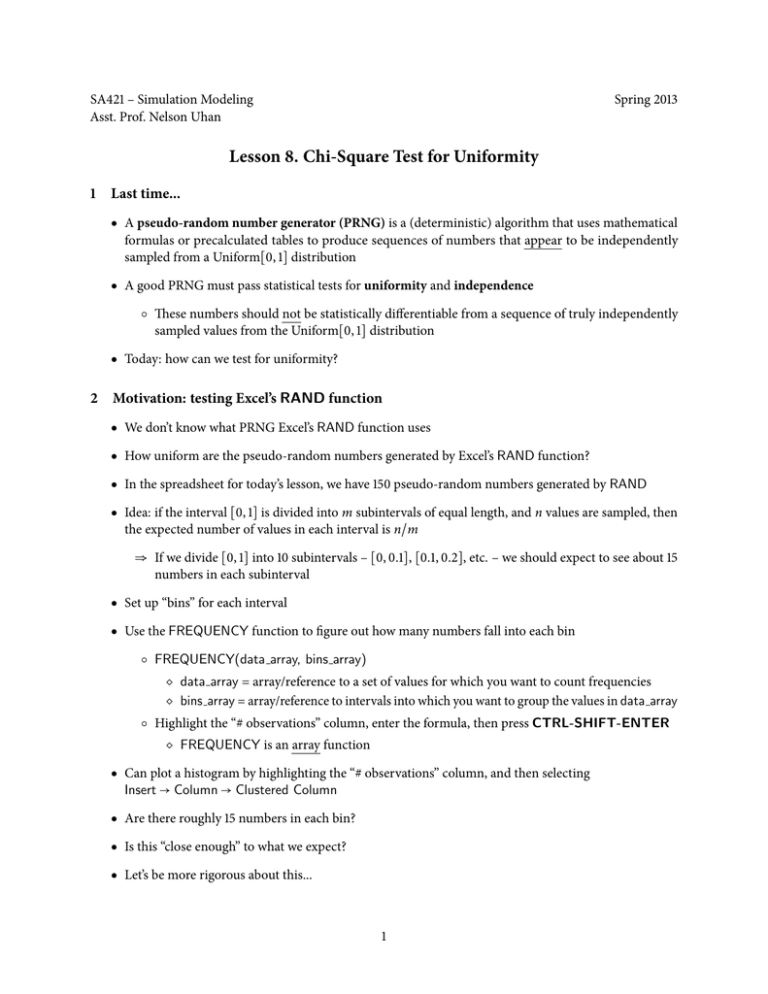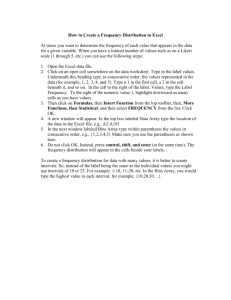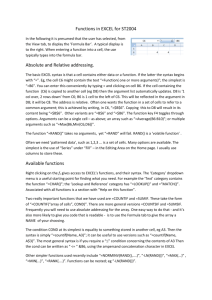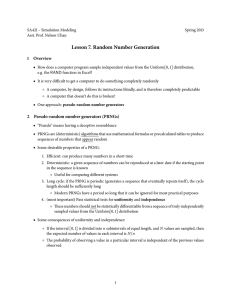Lesson 8. Chi-Square Test for Uniformity 1 Last time...
advertisement

SA421 – Simulation Modeling Asst. Prof. Nelson Uhan Spring 2013 Lesson 8. Chi-Square Test for Uniformity 1 Last time... ● A pseudo-random number generator (PRNG) is a (deterministic) algorithm that uses mathematical formulas or precalculated tables to produce sequences of numbers that appear to be independently sampled from a Uniform[0, 1] distribution ● A good PRNG must pass statistical tests for uniformity and independence ○ These numbers should not be statistically differentiable from a sequence of truly independently sampled values from the Uniform[0, 1] distribution ● Today: how can we test for uniformity? 2 Motivation: testing Excel’s RAND function ● We don’t know what PRNG Excel’s RAND function uses ● How uniform are the pseudo-random numbers generated by Excel’s RAND function? ● In the spreadsheet for today’s lesson, we have 150 pseudo-random numbers generated by RAND ● Idea: if the interval [0, 1] is divided into m subintervals of equal length, and n values are sampled, then the expected number of values in each interval is n/m ⇒ If we divide [0, 1] into 10 subintervals – [0, 0.1], [0.1, 0.2], etc. – we should expect to see about 15 numbers in each subinterval ● Set up “bins” for each interval ● Use the FREQUENCY function to figure out how many numbers fall into each bin ○ FREQUENCY(data array, bins array) ◇ data array = array/reference to a set of values for which you want to count frequencies ◇ bins array = array/reference to intervals into which you want to group the values in data array ○ Highlight the “# observations” column, enter the formula, then press CTRL-SHIFT-ENTER ◇ FREQUENCY is an array function ● Can plot a histogram by highlighting the “# observations” column, and then selecting Insert → Column → Clustered Column ● Are there roughly 15 numbers in each bin? ● Is this “close enough” to what we expect? ● Let’s be more rigorous about this... 1 3 Chi-squared test for uniformity ● Let Y1 , . . . , Yn be n independent random variables in [0, 1] ● Let y1 , . . . , y n be observations of Y1 , . . . , Yn ● Divide [0, 1] into m subintervals of equal length: [0, 1 1 2 m−1 ],[ , ],...,[ , 1] m m m m ● The hypothesis we are testing: if Y represents any of the Yj ’s, ○ We call this the null hypothesis H0 (for this test) ● Let O i be the number of Yj ’s in [ i−1 i , ] for i = 1, . . . , m m m ○ O i is a random variable: uncertain quantity before Yj ’s are observed ○ Let e i = E[O i ] = expected number of observations in [ i−1 i , ]= m m ● Let o1 , . . . , o m be the observations of O1 , . . . , O m ● The test quantity T is ○ T is a random variable that has approximately a chi-squared distribution with m − 1 degrees of freedom when H0 is true ○ Rule of thumb: e i ≥ 5 for i = 1, . . . , m ● The observed test quantity t is ● Small values of t ⇒ evidence in favor of H0 ● Large values of t ⇒ evidence against H0 ● How large does t have to be to reject H0 ? ● The p-value is ○ Interpretation: probability that such a large value of T would have been observed if H0 is true ○ Small p-values (< α, where α is typically 0.05 or even 0.01) ⇒ reject H0 ● Computing this in Excel: ○ CHIDIST(t, m-1) = P(χ2m−1 ≥ t) 2








